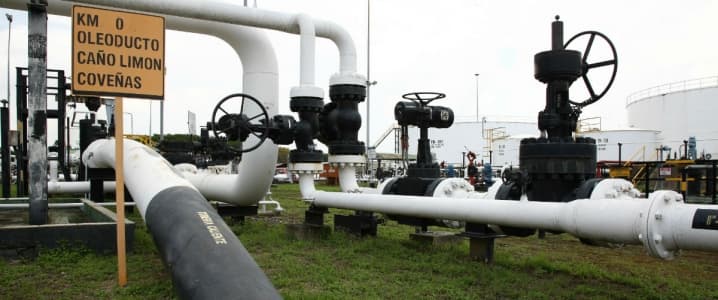Tracking attacks on oil and gas infrastructure in Colombia can be a mammoth task. Since it was inaugurated in 1986, the Caño Limón–Coveñas pipeline, operated by state-owned company Ecopetrol (NYSE:EC), has been targeted at least 1,000 times. According to Ecopetrol, more than 43,000 thousand barrels of crude oil have been spilled into the Arauca basin since 2000 – which explains why it’s colloquially referred to as ‘the flute’.
It took the National Liberation Army (ELN) less than six hours to dynamite the pipeline after the government-brokered ceasefire expired on 09 January 2018. Five days later, video-footage released by local media outlets show ELN operatives kidnapping an Ecopetrol engineer from his office in Saravena, Arauca. These strings of attacks not only take a human toll, but also serve as the worst kind of publicity for a country that continues to attempt to rebrand itself as an attractive base of foreign investment.
Last year, the Colombian Petroleum Association projected private oil and gas investment to grow up to 45 percent in 2018, spurred by the FARC’s demobilisation and a major tax reform bill approved at the end of 2016. However, while the number of attacks on vital oil infrastructure has dropped since the FARC entered civilian life, the ELN and loosely affiliated criminal groups are filling in the vacuum left by the now disbanded guerrilla force.
The prospects for change are likely to remain bleak even as Colombian officials and the ELN’s highest echelons openly push for negotiations to continue. There are substantial factors that will affect future negotiations, and will have a knock-on effect on streams of foreign investment throughout the oil industry.
Weak negotiating positions
While the ELN and the FARC guerrilla groups tend to get cast under the same light, they are ideologically and structurally different. The ELN’s ranks were first filled with middle-class students, catholic militants and left-wing intellectuals who received particular attention from international donors, as opposed to the FARC, who remained largely isolated until Hugo Chavez rose to power in Venezuela.
The ELN developed under a fragmented structure that assured operational flexibility throughout the Colombian territory. However, not all guerrilla fronts developed equally, as some tapped into cocaine production and distribution in their areas of operation. This afforded them a quantitative advantage over fronts who solely relied on kidnappings and extortion as a source of revenue.4 Related: Maduro Proposes OPEC Cryptocurrency
Moreover, financial assistance from external sources such as Caracas – who cemented a relationship with the ELN as much as with the FARC – was lopsided. With Venezuela acting as a host to ELN fronts operating in the bordering Arauca and Norte de Santander Departments, fronts operating in the interior of the country were more frequently targeted and incurred heavier losses.
The ELN is not a homogeneous fighting force. The guerrilla’s highest echelons do not represent every combatant. This is evidenced in the numerous ceasefire violations and outright dismissals of the peace process among several fronts. If the ELN were to negotiate any transition into civilian life, the risk posed by the guerrilla group to many businesses would not change.
Economic hurdles and social challenges
The Colombian government is also unable to negotiate peace under the same conditions it did two years ago in La Havana, and the ELN is unlikely to accept similar terms. Bogota is no longer in the same financial position that allowed it to make serious strides while negotiating with the FARC. Notably, the precipitous fall in oil prices throughout 2014-2015 significantly reduced the country’s oil exports. Bogota’s benchmark crude is currently trading at around $46, less than half its value six years ago when the FARC peace process began.
Social and economic upheaval in neighbouring Venezuela – Colombia’s largest trading partner – has similarly taken its toll on the country’s exports, which have fallen 48 percent between 2013 and 2016. Trade with other Andean nations has likewise seen minor lulls since 2012, which add to the country’s current $1.1 billion trade deficit.
Amid low oil prices and falling exports, the costs of rural development, strengthening infrastructure, and repaying victims of war?—?all included in the peace deal signed with the FARC —??is now expected to require a net additional investment close to 0.6 percent of GDP over the next 15 years. Related: Is WTI Overtaking Brent As The Biggest Global Benchmark?
The ELN on the other hand, has not only witnessed these economic shortfalls, but also tangible constraints affecting peace building in the Andean nation. Former FARC combatants are increasingly targeted in rural areas, crop substitution programs are severely underfunded, and rural development is stagnant. While the aggregate economic benefits of peace are undeniable as a whole, in rural and isolated communities, the most plausible estimate for the aggregate economic benefits on GDP growth is in the low tenths of a percentage point. Without disregarding the importance of peace, rural communities are not seeing the difference peace makes in their lives.
Looking ahead
Although peace negotiations will continue, it is important to understand that both negotiating positions are compromised. The Colombian government can no longer base reform on a bullish oil market, and the ELN is unlikely to bring its dissident fronts into the fold. The oil and gas industry, in the meantime, is unlikely to see a rapid amelioration in the security environment that will guard investment streams. It took Bogota and the FARC four years to reach a settlement; there is no reason to believe that the ELN negotiations will be shorter.
By Konrad Petraitis via Global Risk Insights
More Top Reads From Oilprice.com:
- BP Has Its Most Successful Year This Decade
- U.S. Considers Cutting Venezuelan Oil Imports
- Will Rising Crude Inventories End The Rally?


















